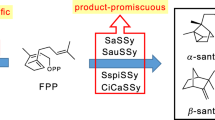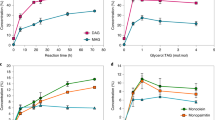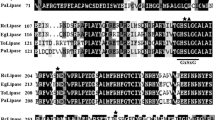Abstract
The biosynthesis of ‘unusual’ fatty acids with structures that deviate from the common C16 and C18 fatty acids has evolved numerous times in the plant kingdom. Characterization of unusual fatty acid biosynthesis has enabled increased understanding of enzyme substrate properties, metabolic plasticity and oil functionality. Here, we report the identification of a novel pathway for hydroxy fatty acid biosynthesis based on the serendipitous discovery of two C24 fatty acids containing hydroxyl groups at the 7 and 18 carbon atoms as major components of the seed oil of Orychophragmus violaceus, a China-native Brassicaceae. Biochemical and genetic evidence are presented for premature or ‘discontinuous’ elongation of a 3-OH intermediate by a divergent 3-ketoacyl-CoA (coenzyme A) synthase during a chain extension cycle as the origin of the 7-OH group of the dihydroxy fatty acids. Tribology studies revealed superior high-temperature lubricant properties for O. violaceus seed oil compared to castor oil, a high-performance vegetable oil lubricant. These findings provide a direct pathway for designing a new class of environmentally friendly lubricants and unveil the potential of O. violaceus as a new industrial oilseed crop.
This is a preview of subscription content, access via your institution
Access options
Access Nature and 54 other Nature Portfolio journals
Get Nature+, our best-value online-access subscription
$29.99 / 30 days
cancel any time
Subscribe to this journal
Receive 12 digital issues and online access to articles
$119.00 per year
only $9.92 per issue
Buy this article
- Purchase on Springer Link
- Instant access to full article PDF
Prices may be subject to local taxes which are calculated during checkout






Similar content being viewed by others
References
Badami, R. C. & Patil, K. B. Structure and occurrence of unusual fatty acids in minor seed oils. Prog. Lipid Res. 19, 119–153 (1980).
Smith, C. R. Occurrence of unusual fatty acids in plants. Prog. Chem. Fats Other Lipids 11, 137–177 (1971).
Broun, P., Shanklin, J., Whittle, E. & Somerville, C. Catalytic plasticity of fatty acid modification enzymes underlying chemical diversity of plant lipids. Science 282, 1315–1317 (1998).
Cahoon, E. B., Lindqvist, Y., Schneider, G. & Shanklin, J. Redesign of soluble fatty acid desaturases from plants for altered substrate specificity and double bond position. Proc. Natl Acad. Sci. USA 94, 4872–4877 (1997).
Cahoon, E. B. & Kinney, A. J. The production of vegetable oils with novel properties: Using genomic tools to probe and manipulate plant fatty acid metabolism. Eur. J. Lipid Sci. Technol. 107, 239–243 (2005).
Dyer, J. M., Stymne, S., Green, A. G. & Carlsson, A. S. High-value oils from plants. Plant J. 54, 640–655 (2008).
Appelqvist, L.-A. Lipids in CruciferaeI. I. Fatty acid composition in seeds of some Svalöf varieties and strains of rape, turnip rape, white mustard and false flax. Acta Agric. Scand. 18, 3–21 (1968).
Miller, R. W., Earle, F. R., Wolff, I. A. & Jones, Q. Search for new industrial oils. XIII. Oils from 102 species of Cruciferae. J. Amer. Oil Chem. Soc. 42, 817–821 (1965).
Miwa, T. K. & Wolff, I. A. Fatty acids, fatty alcohols, wax esters, and methyl esters from Crambe abyssinica and Lunaria annua seed oils. J. Amer. Oil Chem. Soc. 40, 742–744 (1963).
Jart, A. The fatty acid composition of various cruciferous seeds. J. Amer. Oil Chem. Soc. 55, 873–875 (1978).
Mikolajczak, K. L., Earle, F. R. & Wolff, I. A. Search for new industrial oils. VI. Seed oils of the genus Lesquerella. J. Amer. Oil Chem. Soc. 39, 78–80 (1962).
Salywon, A. M., Dierig, D. A., Rebman, J. P. & de Rodriguez, D. J. Evaluation of new Lesquerella and Physaria (Brassicaceae) oilseed germplasm. Am. J. Bot. 92, 53–62 (2005).
Luo, P., Lan, Z. Q. & Li, Z. Y. Orychophragmus violaceus, a potential edible-oil crop. Plant Breeding 113, 83–85 (1994).
Zhou, L., Wu, J. & Wang, S. Orychophragmus in Wild Crop Relatives: Genomic and Breeding Resources (ed. C., Kole) 199–225 (Springer, Berlin, 2011).
Li, Z.-y & Ge, X.-h Unique chromosome behavior and genetic control in Brassica × Orychophragmus wide hybrids: a review. Plant Cell Rep. 26, 701–710 (2007).
Zhao, Z.-g et al. Production and characterization of intergeneric somatic hybrids between Brassica napus and Orychophragmus violaceus and their backcrossing progenies. Plant Cell Rep. 27, 1611–1621 (2008).
Xu, C. & Li, Z. Seed quality and genetic analysis of F12 progenies from intergeneric hybrids between Brassica napus and Orychophragmus violaceus. Chinese. J. Oil Crop Sci. 33, 20–24 (2011).
Wang, R. et al. Orychophragmus violaceus L., a marginal land-based plant for biodiesel feedstock: heterogeneous catalysis, fuel properties, and potential. Energy Convers. Manag. 84, 497–502 (2014).
Kwon, Y., Lee, S., Oh, D.-C. & Kim, S. Simple determination of double-bond positions in long-chain olefins by cross-metathesis. Angew Chem., Int. Ed. Engl. 50, 8275–8278 (2011).
Hoye, T. R., Jeffrey, C. S. & Shao, F. Mosher ester analysis for the determination of absolute configuration of stereogenic (chiral) carbinol carbons. Nat. Protoc. 2, 2451–2458 (2007).
Wakil, S. & Bressler, R. Studies on the mechanism of fatty acid synthesis. X. Reduced triphosphopyridine nucleotide-acetoacetyl coenzyme A reductase. J. Biol. Chem. 237, 687–93 (1962).
Dugan, R. E., Slakey, L. L. & Porter, J. W. Stereospecificity of the transfer of hydrogen from reduced nicotinamide adenine dinucleotide phosphate to the acyl chain in the dehydrogenase-catalyzed reactions of fatty acid synthesis. J. Biol. Chem. 245, 6312–6316 (1970).
Blacklock, B. J. & Jaworski, J. G. Studies into factors contributing to substrate specificity of membrane-bound 3-ketoacyl-CoA synthases. Eur. J. Biochem. 269, 4789–4798 (2002).
Broun, P., Boddupalli, S. & Somerville, C. A bifunctional oleate 12-hydroxylase: desaturase from Lesquerella fendleri. Plant J. 13, 201–210 (1998).
Smith, M. A., Moon, H., Chowrira, G. & Kunst, L. Heterologous expression of a fatty acid hydroxylase gene in developing seeds of Arabidopsis thaliana. Planta 217, 507–516 (2003).
Cermak, S. C. et al. New crop oils—properties as potential lubricants. Ind. Crops Prod. 44, 232–239 (2013).
Asadauskas, S., Perez, J. H. & Duda, J. L. Lubrication properties of castor oil–potential basestock for biodegradable lubricants. Tribol. Lubric. Technol. 53, 35 (1997).
Mobarak, H. M. et al. The prospects of biolubricants as alternatives in automotive applications. Renew. Sustain. Energy Rev. 33, 34–43 (2014).
Quinchia, L. A., Delgado, M. A., Reddyhoff, T., Gallegos, C. & Spikes, H. A. Tribological studies of potential vegetable oil-based lubricants containing environmentally friendly viscosity modifiers. Tribol. Int. 69, 110–117 (2014).
Loewenthal, S. H. & Moyer, D. W. Filtration effects on ball bearing life and condition in a contaminated lubricant. J. Lubric. Technol. 101, 171–176 (1979).
Bach, L. et al. The very-long-chain hydroxy fatty acyl-CoA dehydratase PASTICCINO2 is essential and limiting for plant development. Proc. Natl Acad. Sci. USA 105, 14727–14731 (2008).
Gmeiner, J. & Martin, H. H. Phospholipid and lipopolysaccharide in Proteus mirabilis and its stable protoplast L-form. Difference in content and fatty acid composition. Eur. J .Biochem. 67, 487–494 (1976).
Yano, I., Ohno, Y., Masui, M., Kato, K. & Yabuuchi, E. Occurrence of 2- and 3-hydroxy fatty acids in high concentrations in the extractable and bound lipids of Flavobacterium meningosepticum and Flavobacterium IIb. Lipids 11, 685–688 (1976).
Venter, P. et al. Production of 3R-hydroxy-polyenoic fatty acids by the yeast Dipodascopsis uninucleata. Lipids 32, 1277–1283 (1997).
Jin, S. J., Hoppel, C. L. & Tserng, K. Y. Incomplete fatty acid oxidation. The production and epimerization of 3-hydroxy fatty acids. J. Biol. Chem. 267, 119–125 (1992).
Busta, L. & Jetter, R. Moving beyond the ubiquitous: the diversity and biosynthesis of specialty compounds in plant cuticular waxes. Phytochem. Rev. https://doi.org/10.1007/s11101-017-9542-0 (2017).
Moon, H., Smith, M. A. & Kunst, L. A condensing enzyme from the seeds of Lesquerella fendleri that specifically elongates hydroxy fatty acids. Plant Physiol. 127, 1635–1643 (2001).
Cronan, J. E. & Thomas, J. Bacterial fatty acid synthesis and its relationships with polyketide synthetic pathways. Methods Enzymol. 459, 395–433 (2009).
Kass, L. R. & Bloch, K. On the enzymatic synthesis of unsaturated fatty acids in Escherichia coli. Proc. Natl Acad. Sci. USA 58, 1168–1173 (1967).
D’Agnolo, G., Rosenfeld, I. S. & Vagelos, P. R. Multiple forms of β-ketoacyl-acyl carrier protein synthetase in Escherichia coli. J. Biol. Chem. 250, 5289–5294 (1975).
Cermak, S. C. & Isbell, T. A. Improved oxidative stability of estolide esters. Ind. Crops Prod. 18, 223–230 (2003).
Isbell, T. A., Edgcomb, M. R. & Lowery, B. A. Physical properties of estolides and their ester derivatives. Ind. Crops Prod. 13, 11–20 (2001).
Soni, S. & Agarwal, M. Lubricants from renewable energy sources – a review. Green Chem. Lett. Rev. 7, 359–382 (2014).
Bligh, E. G. & Dyer, W. J. A rapid method of total lipid extraction and purification. Can. J. Biochem. Physiol. 37, 911–917 (1959).
Cahoon, E. B. et al. Conjugated fatty acids accumulate to high levels in phospholipids of metabolically engineered soybean and Arabidopsis seeds. Phytochemistry 67, 1166–1176 (2006).
von Rudloff, E. Periodate-permanganate oxidations. IV. Determination of the position of double bonds in unsaturated fatty acids and esters. J. Amer. Oil .Chem. Soc. 33, 126–128 (1956).
Boeckman, R. K., Shao, P., Mullins, J. J., Minbiole, K. P. & Smith, A. B. The Dess–Martin periodinane: 1,1,1-triacetoxy-1,1- dihydro-1,2-benziodoxol-3(1H)-one. Organic Syntheses 77, 141 (2000).
Brown, H. C. & Bhat, K. S. Hydroboration. 77. Hydroboration of cyclic dienes with representative hydroborating agents. J. Organic Chem. 51, 445–449 (1986).
Donohoe, T. J. et al. Scope of the directed dihydroxylation: application to cyclic homoallylic alcohols and trihaloacetamides. Organic Biomolec. Chem. 1, 2173–2186 (2003).
Kim, J. et al. Arabidopsis 3-ketoacyl-coenzyme Asynthase9 is involved in the synthesis of tetracosanoic acids as precursors of cuticular waxes, suberins, sphingolipids, and phospholipids. Plant Physiol. 162, 567–580 (2013).
Kim, H. J. et al. Toward production of jet fuel functionality in oilseeds: identification of FatB acyl-acyl carrier protein thioesterases and evaluation of combinatorial expression strategies in Camelina seeds. J. Expt Bot. 66, 4251–4265 (2015).
Li, X. et al. A large insertion in bHLH transcription factor BrTT8 resulting in yellow seed coat in Brassica rapa. PLoS ONE 7, e44145 (2012).
Edgar, R. C. MUSCLE: multiple sequence alignment with high accuracy and high throughput. Nucleic Acids Res. 32, 1792–1797 (2004).
Castresana, J. Selection of conserved blocks from multiple alignments for their use in phylogenetic analysis. Mol. Biol. Evol. 17, 540–52 (2000).
Schliep, K. P. Phangorn: phylogenetic analysis in R. Bioinformatics 27, 592–3 (2011).
Cahoon, E. B. & Kinney, A. J. Dimorphecolic acid is synthesized by the coordinate activities of two divergent Δ12-oleic acid desaturases. J. Biol. Chem. 279, 12495–12502 (2004).
Nguyen, H. T. et al. Camelina seed transcriptome: a tool for meal and oil improvement and translational research. Plant Biotechnol. J. 11, 759–769 (2013).
Clough, S. J. & Bent, A. F. Floral dip: a simplified method for Agrobacterium-mediated transformation of Arabidopsis thaliana. Plant J. 16, 735–743 (1998).
Acknowledgements
We thank the National Natural Science Foundation of China (grant number 31370286) and Fundamental Research Funds for the Central Universities (programme number 2662015PY12) for support to C.Z. and the National Science Foundation (Plant Genome IOS-13-39385) and Huazhong Agricultural University Scientific and Technological Self-Innovation Foundation (programme number 2015RC010) for support to E.B.C. NMR and LC/MS instrumentation at IUPUI were acquired with funding from the NSF (grant numbers CHE-0619254 and DBI-0821661, R.E.M.). A.M.T. appreciates support of the NSF (MCB-0919938, R.E.M.) and the Department of Chemistry and Chemical Biology, IUPUI. We thank M.Morton (University of Nebraska-Lincoln) for assistance with preliminary NMR studies, S.Stymne and J.Lindberg Yilmaz (ScanBiRes) for conducting fatty acid elongation assays, and E.Moriyama and A.Voshall (University of Nebraska-Lincoln) for transcriptome assembly and mining.
Author information
Authors and Affiliations
Contributions
X.L., A.M.T., K.D.C., D.B., C.Z., R.E.M. and E.B.C. designed the research. X.L., A.M.T., A.S., J.L., R.E.C., W.Z., L.B., C.Z., R.E.M. and E.B.C. performed the research. Z.L. provided novel research materials and contributed to the research conception. X.L., A.M.T., J.L., R.E.C., K.D.C., D.B., C.Z., R.E.M. and E.B.C. analysed the data. X.L., A.M.T., J.L., K.D.C, D.B., C.Z., R.E.M. and E.B.C. wrote the manuscript.
Corresponding authors
Ethics declarations
Competing interests
The authors declare no competing interests.
Additional information
Publisher’s note: Springer Nature remains neutral with regard to jurisdictional claims in published maps and institutional affiliations.
Supplementary information
Supplementary Information
Supplementary Tables 1 and 2, Supplementary Figures 1–11, and Supplementary Notes 1 and 2.
Rights and permissions
About this article
Cite this article
Li, X., Teitgen, A.M., Shirani, A. et al. Discontinuous fatty acid elongation yields hydroxylated seed oil with improved function. Nature Plants 4, 711–720 (2018). https://doi.org/10.1038/s41477-018-0225-7
Received:
Accepted:
Published:
Issue Date:
DOI: https://doi.org/10.1038/s41477-018-0225-7
This article is cited by
-
Intergrative metabolomic and transcriptomic analyses reveal the potential regulatory mechanism of unique dihydroxy fatty acid biosynthesis in the seeds of an industrial oilseed crop Orychophragmus violaceus
BMC Genomics (2024)
-
Using interdisciplinary, phylogeny-guided approaches to understand the evolution of plant metabolism
Plant Molecular Biology (2022)
-
Rare fatty acids and lipids in plant oilseeds: occurrence and bioactivity
Phytochemistry Reviews (2022)
-
Ectopic expression of cDNAs from larkspur (Consolida ajacis) for increased synthesis of gondoic acid (cis-11 eicosenoic acid) and its positional redistribution in seed triacylglycerol of Camelina sativa
Planta (2021)
-
Nature-Guided Synthesis of Advanced Bio-Lubricants
Scientific Reports (2019)



